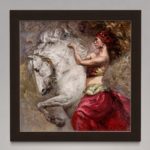Why would anyone spend THAT much on Art?
By Reed V. Horth, for CBP Magazine http://www.cbpmag.com
Several years ago, ROBB REPORT magazine ran a feature on the new Rolls Royce Phantom which was just unveiled. This automobile had a 6.7 Liter V12 with a 0-60 MPH time of 5.7 seconds. This was the pinnacle of automotive perfection. Beautiful, stylish, fast… And, at nearly $450,000, it was solely for the über-rich or the unbelievably crazy.
Right?
The thesis of the ROBB REPORT’S argument was that it did not take a crazy person to spend nearly a half million on a new vehicle, only a rich one. To support this, they pointed to the demographic trends which Rolls Royce employs to great usage. The typical buyer of a Rolls Royce Phantom has liquid assets in excess of $30M USD. Meaning, that they spend approximately 1.5% of their net worth on the purchase of a brand new Phantom. By contrast, the average person spends 20-50% of their YEARLY salary on their vehicle. The buyer of a Phantom generally pays cash, does not negotiate too actively with the dealer and drives away in their vehicle quickly. Whereas the buyer of a mid-range Lexus, BMW or Mercedes will typically finance the vehicle, run credit history, sign myriad forms and negotiate with the dealer to obtain the lowest price and highest options. In short, the buyer of a Phantom is not as adversely affected by the purchase of this expensive vehicle as the average person would be by the purchase of theirs.
Bearing in mind that both vehicle choices tend to be depreciating assets in the short-term, Rolls Royce’s do tend to recover some value back as they are seen as prestige-level classics to later generations. However most of the über-rich will shy from buying anything but brand new, so even these “classics” will still lose something in resale.

During a recent conversation with a client purchasing several Richard MacDonald (American, b. 1946) bronzes from me, we began to discuss a Pablo Picasso (Spanish, 1881-1973) oil painting I was simultaneously working on with another client. Surprised that what appears to be several haphazard scribbles and bright color slathered on canvas could be worth several million dollars, we began to discuss the aforementioned ROBB REPORT article. Demographically, the buyer of a Picasso painting such as this one have liquid assets, annual salaries, investments and mind-sets in a similar category as that of the Rolls Royce Phantom buyer. Further, they typically have homes which could be conservatively called “mansions”. As an owner of a mansion, the Picasso buyer is simply not satisfied with the same framed posters which adorned his dorm-room walls in graduate school, or the decorative prints that the interior designer selected because the colors matched the drapes. Demographically speaking, the Picasso buyer has advanced degrees, has an annual income of above $5M USD, a liquid asset value of +$30M and some other forms of diversified investments. Further, the typical Picasso buyer has dipped their proverbial feet into the art-buying pool and purchased some other works which produced enough pride/prestige/aesthetic appeal/ monetary dividends, etc., to lead them to this point. Further, they typically understand that the Picasso is NOT a depreciating asset and it is a viable way to park money for maturation over a long-term. When the Rolls-Royce Phantom was unveiled in 2009, the price tag of $450,000 could have purchased you a solid mid-1960’s-early 1970’s Pablo Picasso oil on canvas. While the car will presently fetch approximately $250,000, the Picasso will command upwards of $3M USD.
So, I ask you… Who is crazy now?
Reed V. Horth, is the president, curator and writer for ROBIN RILE FINE ART in Miami, FL. He has been a private dealer, gallerist and blogger since 1996, specializing in 20th century and contemporary masters. www.robinrile.com






